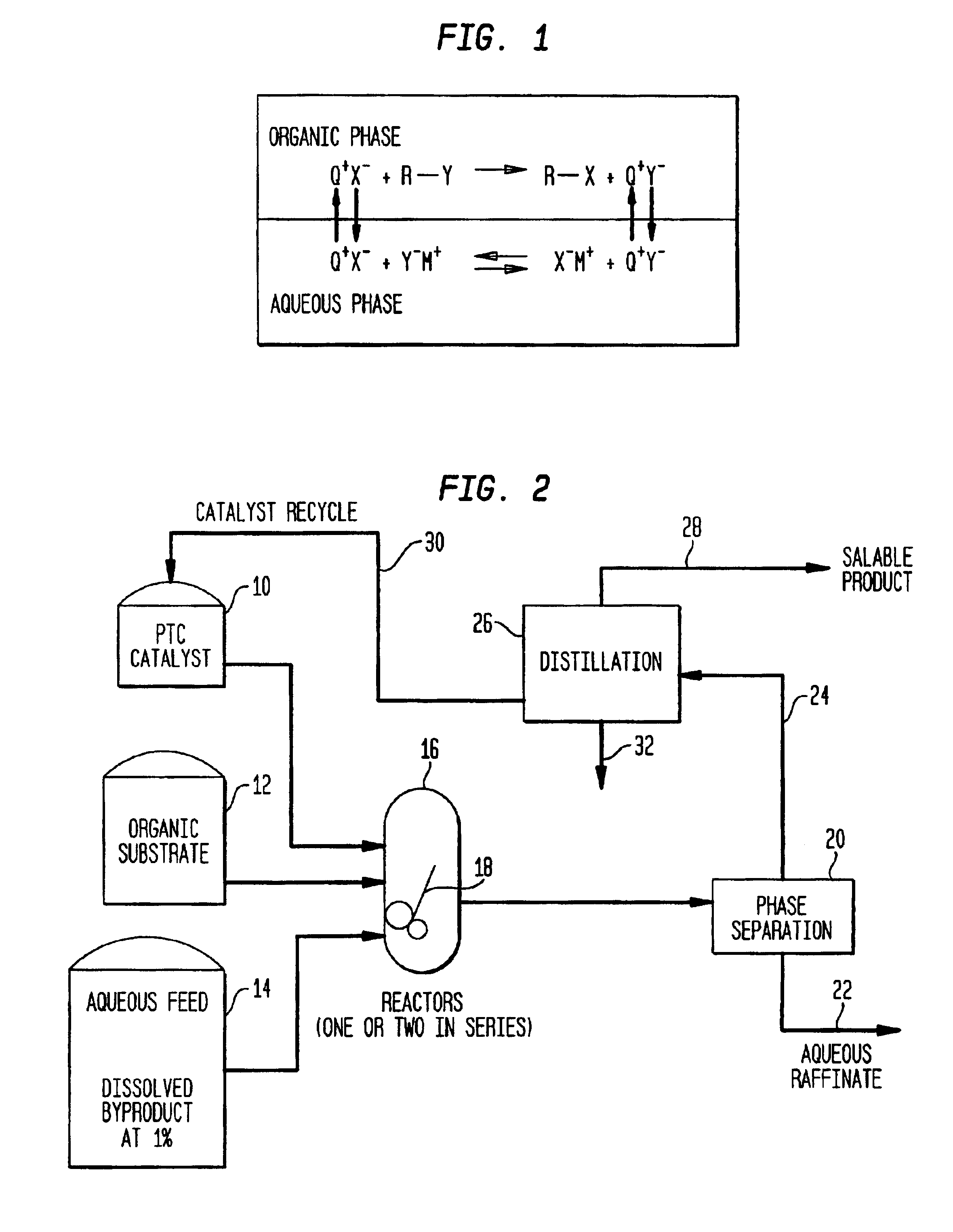Process for making organic products and improving the quality of non-product streams using phase transfer catalysis
a technology of phase transfer and organic products, applied in the direction of physical/chemical process catalysts, ether preparations, halogenated hydrocarbon preparations, etc., can solve the problems of increasing the cost of extraction and recovery of cn, the cost of recovering ry, and the loss of nacn, so as to avoid the cost of waste treatment and save costs. , the effect of cost saving
- Summary
- Abstract
- Description
- Claims
- Application Information
AI Technical Summary
Benefits of technology
Problems solved by technology
Method used
Image
Examples
example 1
Benzyl Cyanide (Phenylacetonitrile)
A mixture consisting of sodium cyanide (2.94 g, 60 millimoles, Aldrich, 95+%), sodium iodide (0.93 g, 6 millimoles, Aldrich, 98%), sodium hydroxide (0.12 g, 3 millimoles, Merck, 97%, to neutralize any possible hydrogen chloride formed from hydrolysis of benzyl chloride), and water (300.63 g) was introduced to a three-necked 500 mL flask and warmed to 40° C. This aqueous solution was treated with a mixture consisting of benzyl chloride (30.38 g, 240 millimoles, Aldrich, 97%), Aliquat 336 (2.58 g, 6 millimoles, Aldrich), and durene (GC standard, 1.34 g, 10 millimoles, Aldrich, 98%), and next, the two phase system was continuously stirred at 600 rpm (the rate of stirring was temporarily checked with a calibrated photo-tachometer from VWR). The organic phase:aqueous phase weight ratio was 1:9. The reaction mixture was kept at constant temperature of 40° C. After 60 minutes of reaction, an aliquot was taken, briefly centrifuged and the phases were separ...
example 2
Benzyl Thiocyanate
A mixture consisting of sodium thiocyanate (1.53 g, 19 millimoles, Aldrich, 98%), sodium iodide (0.15 g, 1 millimole, Aldrich, 98%), copper (I) thiocyanate (0.142 g 1.1 mmoles, Aldrich, 99%), and water (179.25 g) was introduced to a three-necked 500 mL flask and warmed to 40° C. This mixture was then treated with benzyl chloride (7.59 g. 60 millimoles, Aldrich, 97%), benzyl acetate (GC standard, 0.75 g, 5 millimoles, Aldrich, 99+%), and Aliquat 336 (0.86 g, 2.0 millimoles, Aldrich). The organic phase:aqueous phase weight ratio was 1:20. The two phase system was continuously stirred at 600 rpm (the rate of stirring was temporarily checked with a calibrated photo-tachometer from VWR) while the reaction mixture was kept at constant temperature of 40° C. After 180 minutes of stirring, the aliquot was taken, briefly centrifuged and the organic phase was injected into the gas chromatograph. The yield of benzyl thiocyanate based on the limiting reactant (sodium thiocyanat...
example 3
A mixture comprising benzoic acid (2.45 g, 20 millimoles, Aldrich, 99%), sodium hydroxide (1.90 g, 22.5 millimoles, 50% w / w solution in water, Aldrich) and water (247.2 g) was stirred magnetically at room temperature for about two hours until the solids dissolved in water. The excess molar concentration of sodium hydroxide was 0.125. Next, the aqueous phase was transferred to a three-necked 500 mL flask and warmed up to 45° C. The organic phase consisting of benzyl chloride (7.60 g, 60 millimoles, Aldrich, 97%), 3-methylanisole (GC standard, 0.616 g, 5 millimoles, Aldrich, 99%), and Adogen 464 (0.905 g, 2 millimoles, Aldrich) was added to the aqueous phase and the two phase system was stirred mechanically (600 rpm, a calibrated photo-tachometer) for three hours at 45° C. The organic phase:aqueous phase weight ratio was 1:27. The aliquot, taken after 180 minutes after the addition of the organic phase, was briefly centrifuged, the phases were separated and the organic ...
PUM
| Property | Measurement | Unit |
|---|---|---|
| Temperature | aaaaa | aaaaa |
| Temperature | aaaaa | aaaaa |
| Percent by mass | aaaaa | aaaaa |
Abstract
Description
Claims
Application Information
 Login to View More
Login to View More - R&D
- Intellectual Property
- Life Sciences
- Materials
- Tech Scout
- Unparalleled Data Quality
- Higher Quality Content
- 60% Fewer Hallucinations
Browse by: Latest US Patents, China's latest patents, Technical Efficacy Thesaurus, Application Domain, Technology Topic, Popular Technical Reports.
© 2025 PatSnap. All rights reserved.Legal|Privacy policy|Modern Slavery Act Transparency Statement|Sitemap|About US| Contact US: help@patsnap.com

